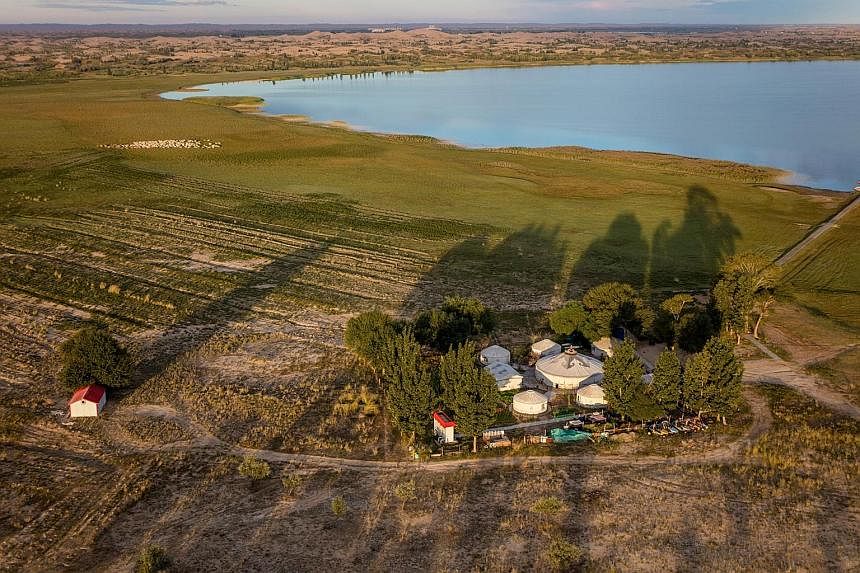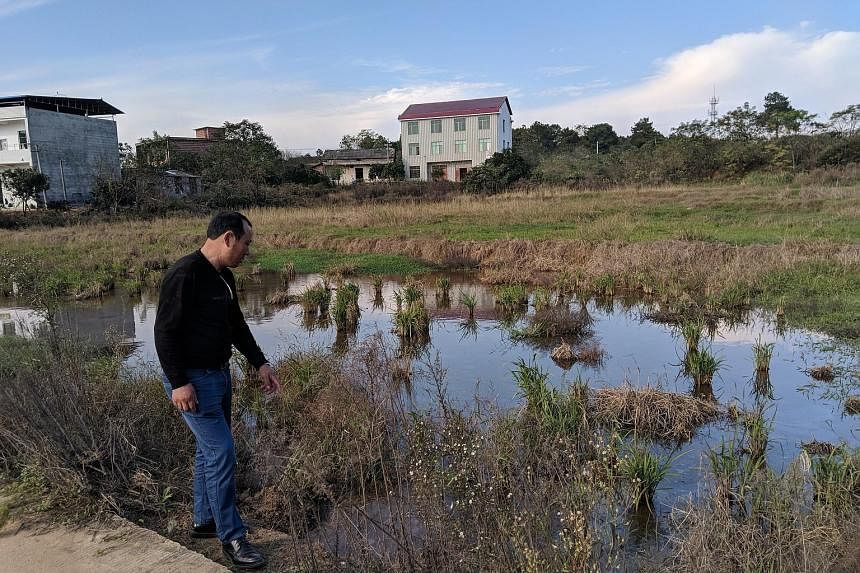In autumn, the stalks of the sand willow turn a deep red, and in the days before the shrub sheds its golden leaves, the Kubuqi desert looks like it is on fire.
This striking sight is becoming more common in the Kubuqi desert these days, as efforts to combat desertification take root. Once an 18,600 sq km expanse of sand dunes stripped of vegetation by decades of overgrazing, over a third of the desert now blooms green.
In the past 30 years, a combined effort by the local government, Chinese eco-firm Elion Resources Group and local herdsmen has pushed back the desert. The Kubuqi is China's seventh largest desert and one of the closest to its capital Beijing, stretching southward from the Yellow River in the Inner Mongolia autonomous region.
Called the Kubuqi Ecological Restoration Project, the scheme has seen flora and fauna return to the desert and improved living conditions for herdsmen. The United Nations Environment Programme estimates the project will create a green economy in the desert worth US$1.8 billion (S$2.5 billion) over 50 years.
The project is part of what is called China's "Great Green Wall", a national-level programme stretching across 13 provinces that aims to stop China's northern deserts from encroaching southward.
It is also an example of how China is beginning to reverse the damage wreaked on its environment during the decades of unchecked economic growth since 1978 when the impoverished nation started reforms to modernise the country and better the lives of its people.
Ethnic Mongolian herdsman Baoyingdalai (who goes by one name) remembers when he was a boy, he and his family had to drive their sheep across great distances in the desert to look for grass.
"In the past, it was a sea of yellow sand, now in the summer it's all green," said the 43-year-old.
Overgrazing was a key reason that conditions deteriorated, said Mr Chang Zhaohui, vice-manager of Elion's Kubuqi Eco-business office. "Before we started to fight desertification, there was very little vegetation, the climate was dry... the ecology and environment were fragile," he said.
To reclaim the desert, officials first planted quick-growing trees like poplars. But when these withered after a few years because of the dry conditions, drought-and cold-resistant shrubs like the sand willow were planted instead, said Mr Gao Yongjie, deputy director of the forestry bureau of Hanggin Banner, a region in Inner Mongolia where the Kubuqi is located.
Subsidies are also given to herdsmen if they plant trees or shrubs on their land, and grazing is prohibited from March to July each year so vegetation has a chance to recover.
As the grass returns, herdsmen like Mr Baoyingdalai have seen their flocks swell. His family now has 500 sheep, from about 80 before.
But Kubuqi's recovery has taken years, and only picked up steam after 2000, as the environment became a bigger government priority.
Mr Gao said when China first began its economic reforms, the government did not have resources to deal with the environment, or regulate how and where herdsmen could graze their flocks. "It became a worsening cycle, but now slowly, managing the ecology is becoming a priority," he said.
POLICY PRIORITY
Fighting pollution is now one of President Xi Jinping's "three critical battles", along with combating poverty and tackling financial risks. He has pledged to build a "beautiful China" by 2050.
The government has backed up that pledge with stricter environmental laws. Since 2012, when Mr Xi took power, China has toughened eight environmental laws, including the key environmental protection law in 2015 to give it more teeth, and passed a new soil pollution law this year. It has also set stricter pollution targets.
It is a sea change from the early days of economic reforms when prevailing dogma classified development as the only "hard truth".
The recent policy changes were propelled in part by public angst that has built up over the years over the country's environmental ills. The list runs long - polluted water bodies like the Huai River and Lake Tai, so-called cancer villages, and vast areas where children have fallen ill because their homes have been contaminated by chemicals from factories.
"China's central leadership sees environmental challenges as strategic threats to the health and progress of the country and ruling party," said Dr Jackson Ewing, senior adviser for sustainability with the United States-based Asia Society Policy Institute.
He said environmental stresses exact significant costs on the economy - through costly environmental clean-ups, and healthcare costs of workers - and threaten to undermine future development.
Mr Ma Jun, director of the Institute for Public and Environmental Affairs, a non-profit environment research organisation, said one of the turning points towards greater transparency and accountability came in late 2011.
Beijing was then facing one of the worse periods of air pollution - serious enough for planes to be grounded and roads closed.
But government statistics on air quality painted a rosy picture of the situation and excluded data on PM2.5 particulates, pollutants small enough to enter the bloodstream.
It led to a public outcry for greater transparency, said Mr Ma. About a year later, the government made public statistics on PM2.5 pollutants in 74 cities. The information allowed the Chinese to take steps to safeguard their health, knowing when they should keep their children indoors, for instance.
"But they weren't satisfied just knowing this, they started to push the government to come up with action plans to solve the problem," said Mr Ma.
In the following years, air quality improved tremendously as polluting firms were forcibly shut. The central government also put pressure on local officials, including in their annual job reviews their ability to lower pollution levels.
But Greenpeace East Asia programme manager Ada Kong said there is still a ways to go in other aspects of the environment including soil pollution, groundwater and biodiversity. "All these happen mainly in the rural parts of China, so there is less public attention," she said.
One such place is the village of Shiqiao in southern Hunan province. The village of about 500 people is known for producing cadmium-tainted rice. In 2013, Greenpeace had traced samples of cadmium-tainted rice sold in neighbouring Guangdong province back to the village's fields.
Shiqiao farmer Zhao Guoping, 52, and other villagers say a nearby chemical-industry park which was built in 2003 is to blame, dumping wastewater into a reservoir the villagers use for irrigation. The water, with an oily slick on its surface, flows into their farmlands.
"Our vegetables don't grow well and our animals are also sick. These streams used to be full of fish and shrimp, but now everything is dead," said Mr Zhao, the exasperation rising in his voice.
Increasingly, such angst is making its way into the public sphere where it is influencing government policy, say experts.
In 2015, a Shiqiao villager sued the factory nearest the village over the pollution. He lost, but the case made headlines and raised awareness of the problem. This year, the local government started treating some of the fields in the village.
The Ministry of Ecology and Environment said in an e-mailed response that over the years, measures to prevent pollution and protect the ecology have been strengthened, listing improvements in PM2.5 readings, water quality and increasing forest cover.
Its spokesman Liu Youbin said at a press briefing on Nov 30 that while there had been historic achievements, environmental problems were still the "weak point" in China's goal to build a "moderately prosperous society".
"Our environmental conditions have improved, but the results of this improvement are fragile... and the environment's situation continues to be grim," he said.
Would President Xi succeed in building a "beautiful China"? Experts are cautiously optimistic but say there needs to be greater transparency coupled with environmental data, to force polluting firms to clean up their act.
A more important question is whether the country can change the minds of people like Mr Li Congfu, also from Shiqiao, who said: "When I think in my heart why the environment is like that now, I feel it's because leaders are not thinking about the lives of the common people."



